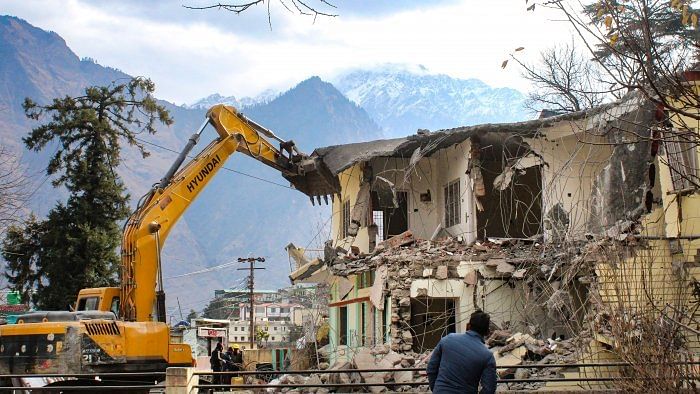
David Harvey, in his work The New Imperialism (2003), introduced the concept of “accumulation by dispossession,” which essentially meant the centralisation of wealth and resources in the hands of a few capitalists by dispossessing the vulnerable population of their wealth and land.
In the Indian context, this theory proved to be right in the neo-liberal era when large tracts of land were acquired for development, infrastructure, and building metropolitan cities. This linear trajectory of development led to infrastructural growth that displaced millions without adequate means for fair compensation, rehabilitation, and resettlement.
Such accumulation of wealth to ensure homogeneous development in both form and nature is also responsible for an increase in the proportion and intensity of disasters.
Also Read | Steps taken in subsidence-hit Joshimath inadequate, declare Himalayas eco-sensitive zone, say experts
While the immediate impact of development resulted in the dispossession of millions from their native places and the destruction of natural habitats, blocking watcher channels, and tearing down aquifers, the long-term impact can be seen in the form of hazards turning into disasters, resulting in major losses of life and livelihoods, and eventually resulting in disaster-induced dispossession.
Disaster-induced dispossession has been recently seen in Joshimath, where land subsidence due to unplanned development forced native families to leave their homes and reach safer places. As per the World Migration Report 2022, in 2020, 30.7 million new displacements were triggered by disasters in 145 countries and territories. The United Nations Refugee Agency (UNHCR) reveals that approximately 50 lakh Indians were displaced in 2021 due to climate change and disasters. India accounted for 4.9 million, which is the third highest internal displacement globally due to disasters after China (6 million) and the Philippines (5.7 million).
Joshimath, a small town with a population of 25,000 and a gateway to Badrinath and Hemkund Sahib, is now undergoing mass displacement of its native population. The onus for such population displacement is the result of decades of uneven development aimed at promoting growth and building world-class infrastructure in the Himalayas’ most vulnerable areas. The immediate response to a situation like Joshimath is to relocate to a safer location, but in the long run, such population displacement not only results in loss of livelihood but can also be viewed as a cultural shock because it deprives them of their sense of belonging.
It was revealed by a 2018 paper published by the Uttarakhand Disaster Mitigation and Management Centre revealed that eight areas along the Main Central Thrust (MCT) in the Himalayas, including Joshimath, are prone to land subsistence. The construction of the 520-megawatt Tapovan Vishnugad hydel power project and the 900-km Char Dham all-weather road in the fragile region of the Himalayas is responsible for this catastrophe. Authorities and government agencies have all toned down the warnings and risks, and the magnitude of such disasters is only realised when they culminate in tangible disasters.
The Disaster Management Law of 2005 does not recognise migration as one of the underlying factors caused by disasters that result in substantial human suffering and loss of livelihood. The National Disaster Management Plan of 2019 remains silent on this issue, with no guidelines or SOPs for those suffering from disaster-induced migration. It is only when such an incident occurs that district administration and response forces come into action. The risk caused by development and anthropogenic activities in the fragile regions remains unaccounted for, and the repercussions of this are being felt by the communities living in these regions.
The fundamental question to ask is: can we afford development or urbanisation in vulnerable areas that result in mass population displacement and the destruction of our natural habitats that are crucial for disaster risk reduction? When development reaches beyond the carrying capacity of the earth, it results in such catastrophic incidences, of which Joshimath is a recent example. Any State action plan for development should be sustainable, keeping in mind the vulnerability of the region, structural limits, and local needs of communities.
(The writer is asst. professor, Jaypee Institute of Information Technology, Noida.)